How to Choose a Professional Range in 2025: Complete Feature-by-Feature Breakdown
October 9th, 2025 | 13 min. read
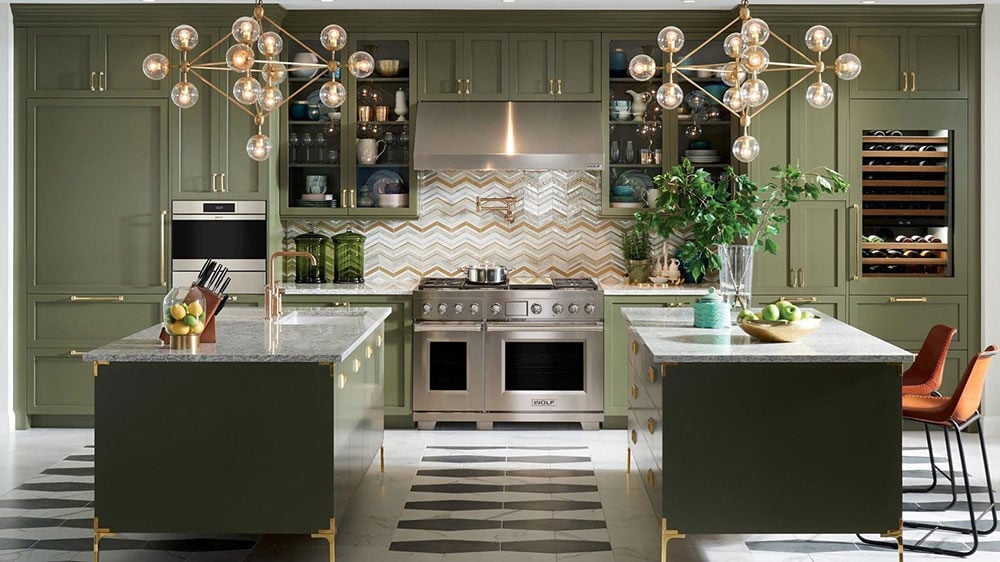
You’re about to spend anywhere from $8,000 to $30,000 on a luxury pro range. That’s exciting, and let’s be honest, a little nerve-wracking too.
Most homeowners, builders, and designers who visit our showrooms from Back Bay brownstones to Cape Cod coastal kitchens all worry about the same thing:
What is the best range on the market?
Here’s the truth: there’s no one best range. But there is a best range for you if you know what to look for.
Today, I’ll break down six of the top brands: Wolf, Miele, Thermador, SKS, BlueStar, and Monogram.
You’ll see exactly what each does best, where they fall short, and how to sidestep a five-figure mistake.
One tip: If you want to see these live, we run chef demos in Boston, Framingham, Hanover, Hyannis, Norton, and Nantucket.
Let’s get it right the first time—so you love what you cook on every day.
How to Choose the Best Professional Range in 2025
1. Size: Will It Even Fit?
First things first, let’s pick the right size.
If you have an open-plan, look below to see the feature differences between 30-, 36-, 48-, and 60-inch ranges.
30 Inches
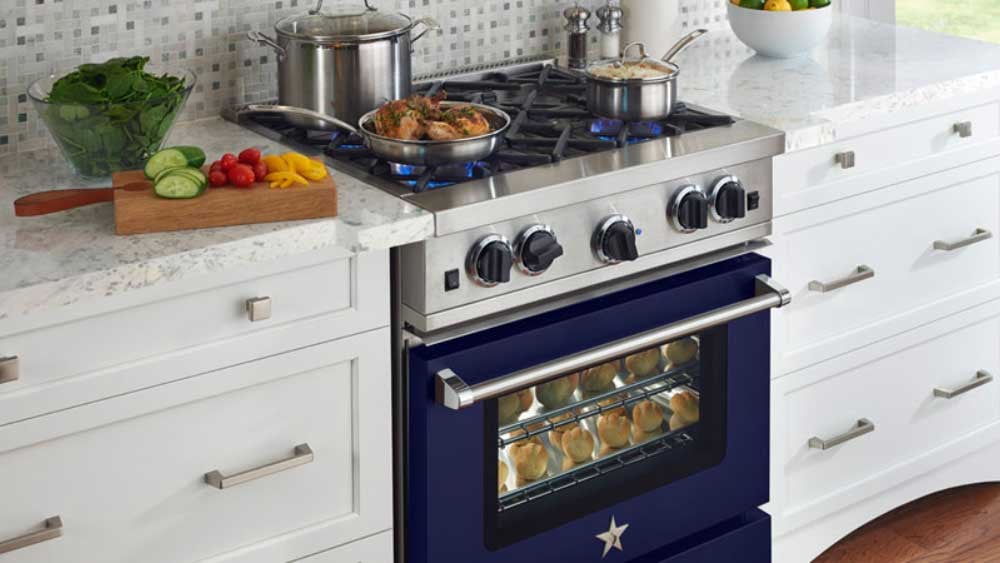
Standard for most Boston-area homes. Four or five burners. Swaps in easily for your old range.
36 Inches
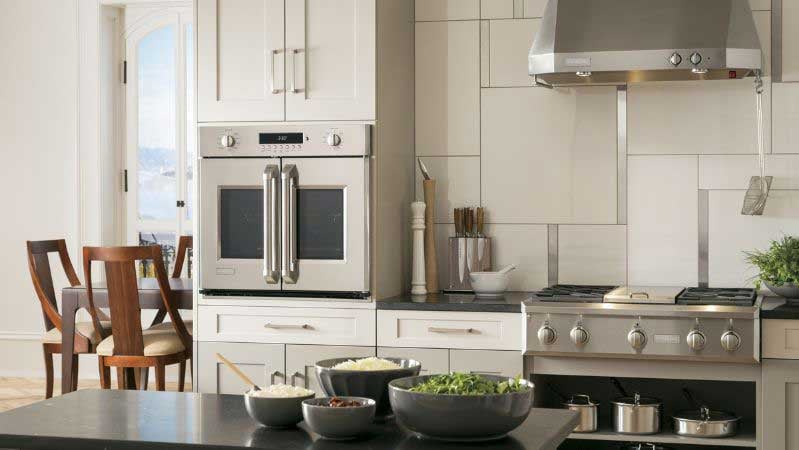
More oven space. Room for a built-in grill or griddle. A sweet spot for cooks who entertain.
48 Inches
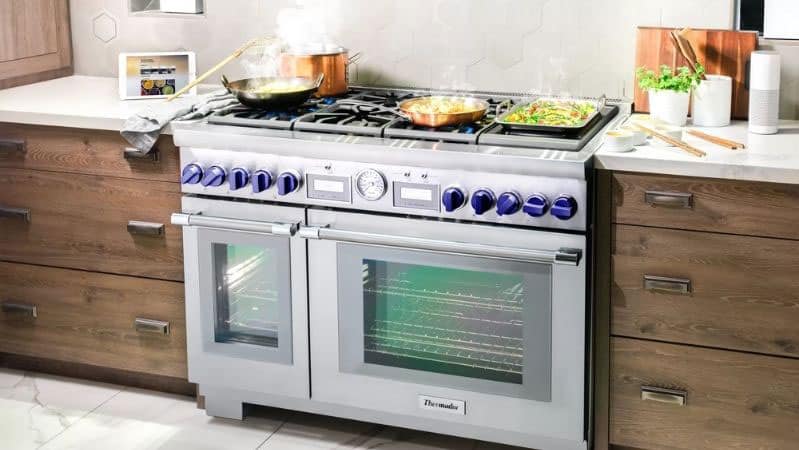
A real chef’s setup. Extra row of burners, griddle or French top (a flat metal plate you slide pots across for different heat zones).
Every 48-inch range has a second, smaller oven. Some add a steam or speed oven too.
60 Inches
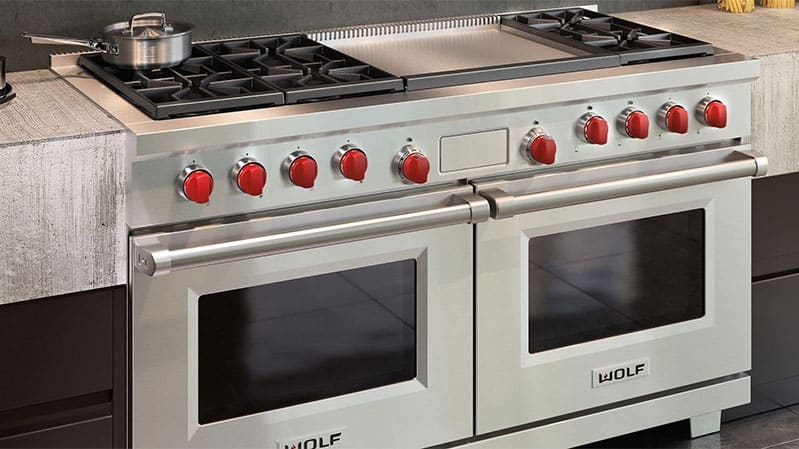
Basically your own restaurant at home. Maximum burners, multiple grills, griddles, French tops, plus extra ovens for baking, steaming, or warming.
Not every brand goes that big. Only Wolf, Thermador, and BlueStar make 60-inch ranges.
📍 Local tip: We crane professional ranges into Boston homes every week. Boston doorways are narrow, and Cape cottages are even tighter.
Measure every doorway, stairwell, and corner against your current range before committing to that 48- or 60-inch model.
2. Fuel: Gas vs. Dual Fuel
Before you pick a brand, sort out your fuel. It trips up more buyers than you’d think, and it affects how your food actually cooks.
All-gas means gas burners on top and a gas oven below. Gas ovens produce moist heat, which keeps big roasts and poultry juicy.
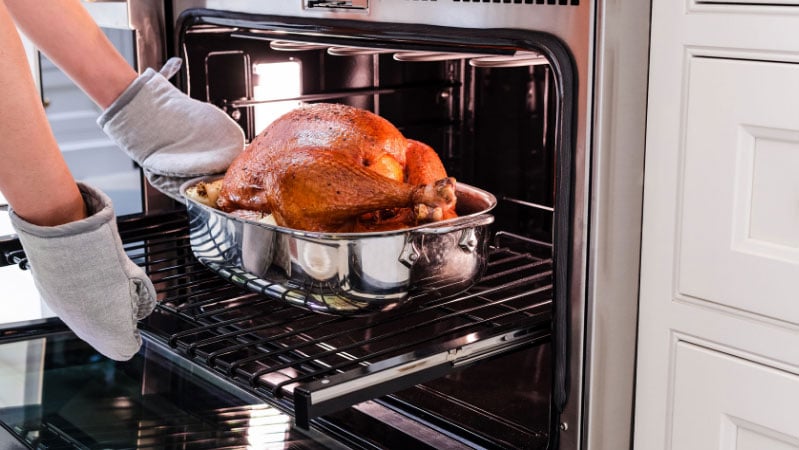
Plus, they heat fast and have powerful infrared broilers that deliver intense direct heat to sear your food.
All-gas ranges are simpler and usually cost about 10–15% less than dual fuel. They also need less electrical power, which can save you an upgrade if you live in an older Boston home.
The catch? Gas ovens can be a bit uneven for delicate baking—not ideal for cakes or pastries.
Dual fuel pairs gas burners on top with an electric oven below.
Electric ovens hold a steady, dry heat, perfect for bread, pastries, and delicate desserts.

Only electric ovens offer extras like steam or speed ovens.
Many dual-fuel models also include smart cooking modes and even induction zones for fast boils and precise simmering.
Broiling? Gas still wins. Electric broilers are fine, but a true gas infrared broiler is faster, hotter, and gives you that steakhouse finish in your own kitchen.
All-Gas vs. Dual Fuel Range Comparison
| All-Gas Range | Dual-Fuel Range | |
| Baking | Less even — moist heat, good for general cooking but tricky for pastries. | More even — dry heat, perfect for precise baking. |
| Roasting | Moist heat keeps roasts juicy — excellent for big cuts and poultry. | Dry heat — precise for slow roasts, but can dry out meat if you’re not careful. |
| Broiling | Gas infrared broiler — hottest, fastest, best for steakhouse crusts. | Electric broiler — effective, but slower and less intense than gas. |
| Special Features | Simpler — no steam or speed ovens. | Adds steam ovens, speed ovens, induction, smart modes. |
| Electrical Amps | Lower — often 15–20 amps, easier for older homes. | Higher — often 40–50 amps for the electric oven and extras. |
| Average Cost | About 10–15% less than dual fuel. | More expensive — extra features add cost. |
Quick takeaway:
- Pick all-gas if you grill, roast, or broil more than bake and want that juicy roast and unbeatable broiler.
- Pick dual fuel if you bake, love modern extras, or want steam and speed ovens.
But that’s only half the story. You also want that burner to hold a gentle, steady simmer when the sauce needs patience.
Here’s how the top brands stack up:
- Wolf: Famous for dual-stacked sealed burners up to 20,000 BTUs. High heat when you want it, plus a true melt-and-hold simmer when you don’t. Extras include built-in grills, griddles, or a French top for multiple heat zones.
- BlueStar: Pure firepower up to 25,000 BTUs. The new dual-fuel line adds sealed burners for easier cleaning. Options for a griddle or even a double griddle if pancakes are your religion. BlueStar and Wolf offer the most range configurations.
- Thermador: Known for the signature Star Burners, a unique open design that spreads heat wide and evenly. One burner reaches 22,000 BTUs. Some models add induction zones for ultra-fast boils and precision simmering.
- Miele: Output tops out at 19,500 BTUs. Many models include an infrared gas grill and/or griddle. Miele has the best M Touch MasterChef controls. You enter the food and how you like it cooked, and the range calculates time and temperature. Like Wolf, but with added steam assist. Their 48-inch model includes an oven, a speed oven as the secondary oven, and a warming drawer.
- Monogram: Brass burners up to 23,000 BTUs. Add an infrared charbroiler or wok burner for big heat and quick stir-fries. The smart tech includes a Hestan Cue burner that cooks by recipe automatically.
- SKS (Signature Kitchen Suite): Two Ultra-High burners at 23,000 BTUs, plus induction zones and a built-in sous vide module for pro-level precision right on the cooktop.
📍 One local truth: More BTUs mean more heat and more smoke. If you opt for a large power burner or add a charbroiler, pair it with a robust ventilation system. We see too many new owners forget this part until the smoke alarm throws a party no one invited.
3. Cooktop: Burners, Griddles & Extras
You’ve chosen your size and picked between gas, dual fuel, or induction. Now, let’s focus on the stovetop. Here’s how to choose the best configuration for your cooking style.
High Burner Output

Need intense heat for lobster or large pots of pasta? BlueStar’s Platinum series delivers the most overall power with multiple 25,000 and 18,000 BTU burners.
Monogram, SKS (Signature Kitchen Suite), Fisher & Paykel, and Viking all offer 23,000 BTU burners. Wolf and JennAir top out at 20,000 BTUs.
At the lower end, Thermador’s Pro Harmony series and Wolf’s all-gas ranges offer 18,000 and 15,000 BTUs, respectively.
Low Burner Output for Simmering
Thermador and SKS advertise the best simmer burners, with two burners that cycle on and off to maintain a 100 BTU average.
Wolf’s burners, by contrast, can simmer steadily at 340 BTUs on every burner.
Induction burners, however, offer the widest temperature range and the lowest, most precise simmering.
Many brands now offer induction modules or full induction ranges—even in 36- and 48-inch sizes.
Griddles
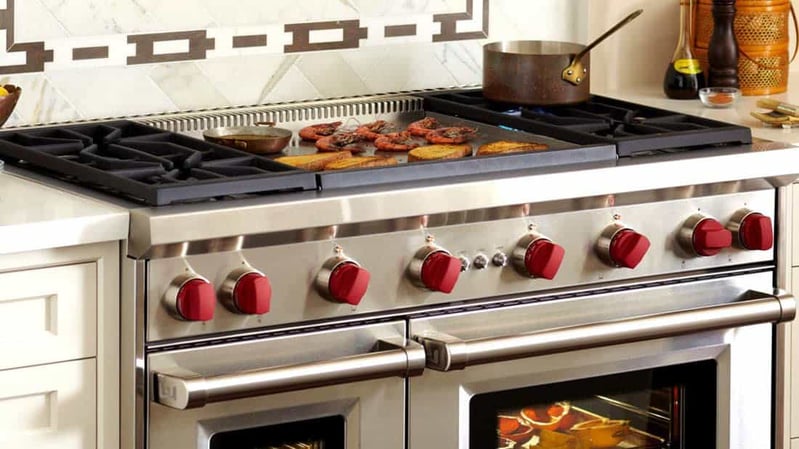
Griddles can cook just about anything.
Go to any diner, and you’ll see them in action.
The old Yale Appliance showroom was across from Demos Cafe, where you could watch omelets, hash browns, hot dogs, and burgers all made on one griddle.
If you’ve been to Fenway Park, you’ve seen sausage vendors doing the same.
But not all griddles are created equal.
- Gas-powered griddles, like those on Wolf and Miele ranges, heat up quickly.
- Monogram’s 18,000 BTU gas griddle includes a temperature display for recipe-based cooking.
- JennAir and SKS use chromium-finished griddles, which are the easiest to clean—no scraping, just wiping.
- Thermador and JennAir offer electric griddles for consistent temperatures, but they take longer to heat up than gas or infrared.
Most pro ranges have a 12-inch griddle. On larger 48- or 60-inch models, you can upgrade to a 24-inch version.
🔍Read More: Should You Buy a Griddle for a Professional Range?
Grills
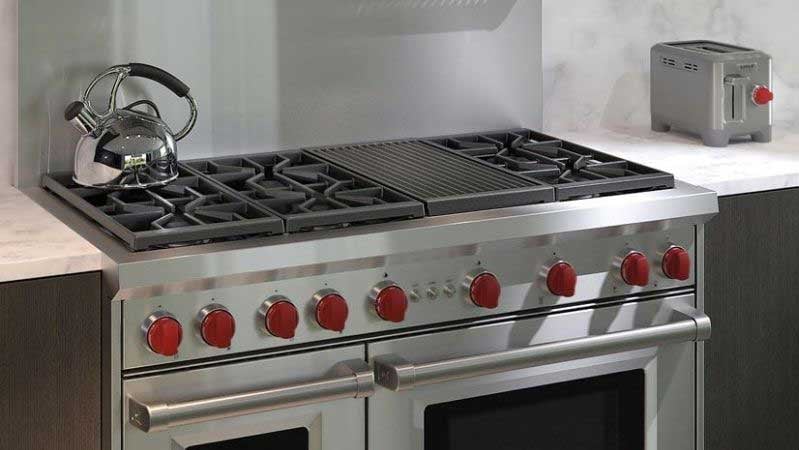
The best built-in grill for a pro range is an infrared model. It delivers intense, direct heat for a fast, even sear—just like a high-end Lynx grill.
Lynx offers 23,000 BTUs. The average is around 16,000 BTUs.
Infrared grills are also easier to clean. Drippings evaporate instead of clogging burners like on gas or electric grills.
Miele, JennAir, Monogram, and Wolf use infrared grills. Viking and BlueStar use standard gas, which spreads the flame more and isn’t as direct.
Depending on the range size, you can choose a 12- or 24-inch grill.
Just remember to pair any indoor grill with a powerful ventilation hood.
🔍Read More: Professional Range Built-In Griddles vs. Grills
French Tops

French tops resemble griddles but function differently. They feature a single central burner and are designed for cooking multiple items at different temperatures.
You keep food in pans on a French top, rather than placing it directly on the surface like a griddle.
Brands offering French tops include Wolf, BlueStar, and La Cornue.
🔍Read More: What Is a French Top Range and Should You Buy One?
Sous Vide Panels
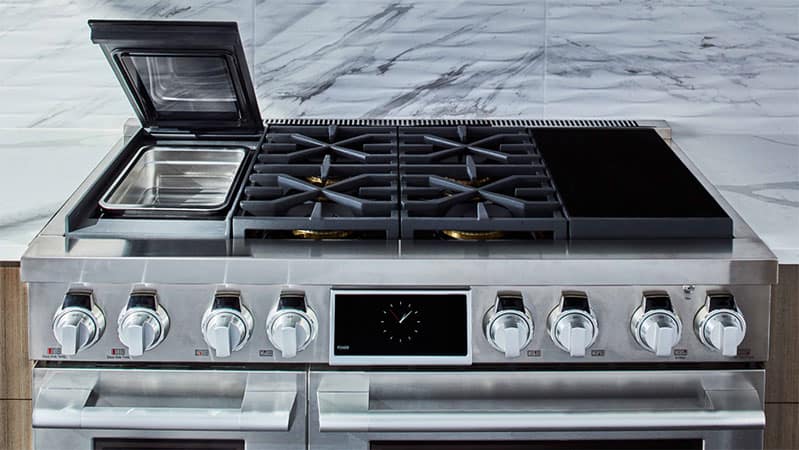
Sous vide cooking uses water immersion to maintain exact internal temperatures.
If you’ve ever boiled a frozen dinner in college, the concept is familiar, but sous vide is much more precise. It’s popular among chefs because it locks in flavor and texture, even after reheating.
Only SKS currently offers a sous vide panel on a pro range.
Induction Burners

Induction cooking uses magnetic energy to heat the cookware directly. The burner stays cool to the touch, and the pan does the work.
Induction is faster than gas, boils water quicker than even a BlueStar burner, and simmers more precisely than any low-temp gas burner.
It’s also safer. Induction burners only activate when a magnetic pan is on the surface—no pan, no heat.
Several pro ranges now offer a hybrid of gas and induction:
Thermador and SKS include two induction burners on select models.
Fisher & Paykel’s 48-inch range pairs four gas burners with a 24-inch induction surface.
If you prefer full induction, most brands now offer 36-inch models. Wolf, Fisher & Paykel, AGA, and Fulgor Milano even offer 48-inch versions.
💡Pro Tip: Use a magnet to check if your cookware is induction-compatible. If it sticks, it works.
Cooktop Power & Extras Comparison
Here’s how the leading pro ranges stack up on raw power, simmer control, and built-in options.
| Max Burner BTU | Lowest Simmer BTUs | Griddle Option | Charbroiler/Grill | Sous Vide / Induction | |
| Wolf | 20,000 BTUs | ~300 BTUs (dual-stacked burner) | Yes | Yes | No induction, no sous vide |
| BlueStar | 25,000 BTUs | Open burners — can go as low as 130°F with practice | Yes (griddle, double griddle) | No charbroiler | No induction, no sous vide |
| Thermador | 22,000 BTUs | 100°F ExtraLow simmer (2 burners) | Yes | No charbroiler | Induction zones available |
| Miele | 19,500 BTUs | ~500 BTUs (sealed) | Yes (infrared griddle) | Infrared charbroiler | No induction, no sous vide |
| Monogram | 23,000 BTUs | ~140°F melt setting | Yes | Infrared charbroiler, wok burner | No induction, no sous vide |
| SKS | 23,000 BTUs | 100°F precision simmer (2 burners) | Yes | No charbroiler | Induction zones, built-in sous vide |
📍 Local tip: Bigger burners and indoor grills create more smoke and grease. Pair them with a 600-CFM (or higher) range hood that’s at least as wide as your range.
Quick takeaways:
- Need brute heat? Look at BlueStar or Hestan.
- Want the lowest simmers and safest surface? Induction wins every time.
- Prefer diner-style versatility? A built-in griddle or grill is your friend—just be sure your ventilation can keep up.
4. Oven: Capacity, Convection, & Smart Tech
The cooktop gets all the hype, but your oven quietly decides if dinner’s a win or a flop.
Capacity:
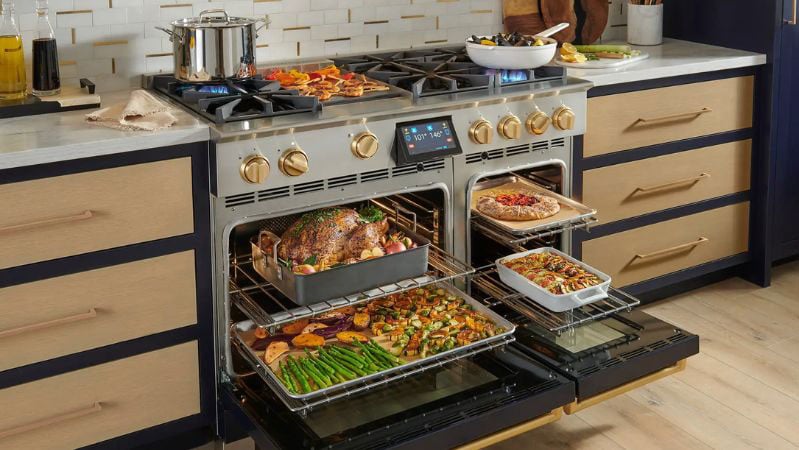
If you’re hosting holidays or cooking for a crowd, you’ll want room for that turkey, big roasts, or multiple dishes at once.
- BlueStar: Large single convection oven in dual fuel and a classic gas radiant oven in all-gas (no fan). Many chefs love the pure gas heat for pizza, bread, and big roasts.
- Wolf, Miele, Monogram, SKS: Plenty of space for big meals. Larger models add a second oven, steam, or speed oven.
- Thermador: Generous capacity with single convection. On 48- and 60-inch models, you can add a separate steam oven for extra flexibility.
Convection:

Convection means a fan moves hot air around for more even baking. True convection means an extra heating element wraps that fan for perfectly even results.
Here's a quick guide:
- Wolf: Dual convection with extended elements dubbed “VertiFlow.” Two fans provide steady, even heat and quick preheat.
- Miele: TwinPower fans are the next best.
- Thermador: Single convection plus a third heating element. Larger ranges can add a dedicated steam oven.
- Monogram: True European convection with Direct Air, so air flows from the top for crisp edges and even browning.
- BlueStar: Single convection only on dual fuel. For all-gas, SKS and BlueStar are the only brands with third-element convection. (BTW, pure, true, European, and third-element are all the same thing.)
- SKS: True convection paired with steam or speed ovens in the larger sizes.
Visual Examples:






Smart Tech:
Today’s ovens can think for you—or stay manual if that’s your style.
- Wolf: Gourmet Mode picks the temp, time, and rack. Tell it what you’re cooking, and it handles the rest.
- Miele: MasterChef does the same as Wolf except for the rack position. It also adds steam bursts for bread. Many models include speed ovens and warming drawers.
- Thermador: Larger models often include steam ovens and warming drawers for extra flexibility.
- Monogram: SmartHQ app lets you run your oven from your phone.
- SKS: Color touchscreen controls steam, sous vide, and speed ovens.
- BlueStar: Dual fuel models now feature a 7-inch touchscreen to guide oven cooking, but there’s no Wi-Fi or app. All-gas ovens remain fully manual.
Visual Examples:


.jpg?width=1200&length=1200&name=Thermador-Professional-Range-With-Steam-Oven%20(1).jpg)



Quick takeaway:
If you love to bake or want smart features that handle the guesswork, Wolf, Miele, Thermador, Monogram, and SKS are all strong picks. If you want classic gas heat and total control, BlueStar keeps it simple and chef-approved.
📍 Want to see the difference? Visit a live chef demo in one of our Boston, Framingham, Hanover, Norton, Hyannis, or Nantucket stores.
5. Controls: Smart vs. Simple

Here’s where some people love the tech, and others just want knobs.
Your controls decide whether your range helps you think or simply does exactly what you say.
How the top brands stack up:
- Wolf: 7-inch touchscreen with Gourmet Mode. Pick your dish, and it picks the settings. Simple and intuitive.
- Miele: M Touch display—sleek, fast, and easy to navigate. MasterChef guides you through hundreds of recipes with steam assist functionality. The speed oven combines convection and microwave.
- Thermador: Clear, simple touch screens. Not as many guided modes, but proven and easy to run.
- Monogram: 7-inch screen plus SmartHQ app. Includes Hestan Cue functionality.
- SKS: Full-color display runs steam, sous vide, and speed ovens, plus full remote control.
- BlueStar: The new dual fuel line has a 7-inch touchscreen for guided cooking, but no Wi-Fi or app. Just pure local control with a modern touch.
Controls and Connectivity Comparison
| Control Type | Screen Size | Wi-Fi / Remote App | |
| Wolf | Touchscreen with Gourmet Mode | 7 inches | No Wi-Fi - local only |
| Miele | M Touch display with MasterChef | Control Panel | No Wi-Fi - local only |
| Thermador | Touchscreen | Varies/Basic | Some models Wi-Fi enabled |
| Monogram | Touchscreen + SmartHQ app | 7 inches | Yes, full remote |
| SKS | Full-color touchscreen + remote | 7 inches+ | Yes, full remote control |
| BlueStar | Touchscreen (dual fuel only) | 7 inches | No Wi-Fi |
Quick notes:
- Wolf & Miele: Guided cooking, robust screens
- Thermador: Some models add Wi-Fi and smart recipes. Single controls
- Monogram & SKS: 7 inch screens, good functionality
- BlueStar: New screen brings a good number of modes, but stays local — no Wi-Fi, no app.
6. Design: Style & Customization




Back in the day, you got stainless or stainless. Today? You’ve got options to make your kitchen yours.
How the brands stack up:
- Wolf: The classic pro look in stainless with iconic red knobs, or swap in black, stainless, or brass knobs to match your style. Newer models are also available in black or white powder-coated finishes for a modern twist.
- BlueStar: The customizer. Choose from over 1,000 colors, six trims, and endless knob combinations. If you want your range to match your cabinets, island, or even your favorite car, BlueStar says, “Why not?”
- Miele: Clean, modern lines in fingerprint-resistant stainless with flush handles and subtle branding. Quietly luxurious.
- SKS (Signature Kitchen Suite): Polished pro look with built-in handles and a seamless design. High-tech but timeless.
- Thermador: Refined pro styling with signature blue indicator lights and crisp finishes. Balances bold and classic.
- Monogram: Modern luxury with seamless stainless, brass accents, and LED backlit knobs you can match to your mood or party theme.
📍 Local note: 75% of all BlueStar ranges are purchased in a custom finish. We serve traditional areas like Boston, Hingham, Wellesley, Nantucket, and Gloucester.
You can consider it in yours. If you’ve watched one of our webinars, you know a pop of color on the range is a great way to make your kitchen truly unique.
It’s your kitchen. Make it unique to you.
Quick takeaway:
Pick a design that makes you smile every time you walk in. The right range should cook beautifully and look like it belongs in your home.
🔍Read more: 10 Best Kitchen Appliance Brands for Color
7. Pricing & Final Verdict
So, what’s this really cost? Expect to spend $8,000 to over $30,000, depending on size, fuel type, finish, and all the extras that make cooking a joy.
Ballpark range:
- Monogram: $7,000–$10,000 for a 36-inch, $14,000–$16,000 for larger builds.
- Thermador: $8,000–$12,000 for smaller models, $15,000–$20,000+ fully loaded with steam.
- Wolf: $10,000–$15,000 for a 36-inch, $20,000–$30,000+ for a top-end 48- or 60-inch.
- BlueStar: $11,000–$14,000 for a 36-inch, $16,000–$20,000+ for custom color and trim.
- Miele: $12,000–$15,000 for standard setups, $20,000+ with speed or steam ovens.
- SKS: $11,000–$13,000 for a 36-inch, $16,000–$18,000+ for a feature-rich 48.
Who’s each brand for?
- Best Controls: Wolf and Miele Dual Fuel Ranges
- Best Tech: SKS and Monogram
- Most Output and Customization: BlueStar
📍 One final reminder: these ranges are serious investments. Our local service teams handle repairs and maintenance in-house across Greater Boston, Cape Cod, and the Islands. No call centers, no runaround—just real help when you need it.
FAQs
Answers to the most commonly asked questions about buying professional ranges.
Which luxury range brand is the most reliable?
Wolf and Thermador consistently rank at the top of our service data. But we service every brand we sell in-house-so if reliability is your biggest worry, ask us for the latest real numbers before you buy.
Is an all-gas oven really better for roasting?
Yes. Gas ovens create a moist heat that’s great for roasts, big cuts, and poultry. Electric ovens are drier and better for precise baking—so if you bake a lot, dual fuel is worth it.
What makes dual fuel worth the extra money?
If you bake breads, pastries, or delicate desserts, an electric oven’s steady dry heat makes a big difference. Dual fuel also unlocks extras like steam, speed ovens, and smart modes you can’t get with all-gas.
Do I really need special electrical work for dual fuel?
Maybe. Many older Boston homes don’t have a dedicated 40–50 amp line for a big electric oven. We always check this before you buy—and if you need an upgrade, we’ll help you plan for it.
How fast can you deliver and install?
We stock most popular sizes—so if you’re in Greater Boston, Cape Cod, or the Islands, many models can be delivered same day or next. And yes—we handle installation too.
Who fixes it if something breaks?
We do. No call centers, no finger pointing. Just local Yale techs with real parts, real trucks, and real answers. That’s the biggest difference between a dream kitchen and a nightmare call center runaround.
Additional Resources
Educate yourself before you buy. Get our detailed Pro Range Buying Guide and compare all gas versus dual fuel ranges from brands like Thermador, Viking and Wolf. Over a million people have made smarter kitchen choices with our guide.
Related Articles:
- Best 36-Inch Professional Ranges
- Best 48-Inch Professional Ranges
- Most Reliable Professional Ranges
- The Ultimate Guide to Buying a Professional Range
Recent Posts
Why Should You Trust Us?
It seems that every appliance review has nothing but glowing comments about almost every product, yet you read customer reviews and they are almost universally bad.
We are here to fill in the disconnect. We'll give you the best features, and the drawbacks as well, including reliability based on over 37,000 calls performed by our service team just last year. Our goal is to give you ALL the information so you know what's right for you.
Please consider subscribing or adding to the conversation in the comments below. We appreciate you stopping by.
Steve Sheinkopf is the third-generation CEO of Yale Appliance and a lifelong Bostonian. He has over 38 years of experience in the appliance industry, and he is a trusted source of information for consumers on how to buy and repair appliances.
Steve has also been featured in numerous publications, including the
New York Times,
Consumer Reports,
The Boston Globe,
Bloomberg Radio, the
New York Post,
The Wall Street Journal, and
Entrepreneur, for his knowledge of how to buy appliances and appliance repair.
Steve is passionate about helping consumers find the best appliances for their needs, and he is always happy to answer questions and provide advice. He is a valuable resource for consumers who are looking for information on appliance buying, repair, and maintenance.
Despite being the worst goalie in history, Steve is a fan of the Bruins and college hockey, loves to read, and is a Peloton biker. The love of his life is his daughter, Sophie.
A Note About Pricing
Pricing on this blog is for reference only and may include time sensitive rebates. We make every attempt to provide accurate pricing at time of publishing. Please call the stores for most accurate price.
Topics:



